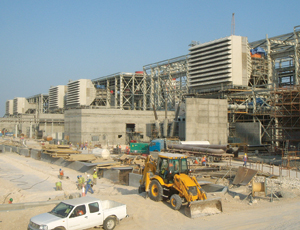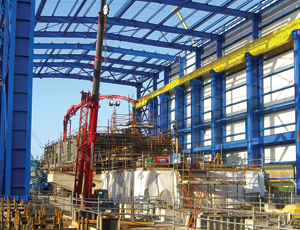Last year, the big news in the international powerplant design and construction sector was the unprecedented boom in coal-fired plant work in China, India and other fast-growing, “emerging” economies. That work continues, albeit at a somewhat more hesitant pace. But the overriding question now is: Will the worldwide financial crisis and the bleak economic outlook lead to a dramatic drop in the development of new generating capacity?


So far, all seems relatively well. While almost every major power-generation and transmission-line company is keeping a close eye on global economic news, most expect to move forward in 2009 with the plants and line projects they have been developing through 2008. Plans for scores of office buildings and other commercial-construction projects have been canceled or delayed in many markets around the world, “but we have not seen that in the power sector so far,” says Keith Hawksworth, CEO of New York City-based Parsons Brinckerhoff.
Hawksworth acknowledges that some slowdown in the pace of powerplant development is likely, given the slackening pace of economic growth in China and slumping energy prices, which may well cause Middle Eastern clients to stretch out the schedules of planned power projects. But engineering and construction companies “had been struggling to keep up” with the multibillion-dollar plans for new powerplants in the fastest-growing markets, so a modest slowdown would still keep most firms very busy, says Hawksworth.
Hawksworth says that PB’s current projects include work as owner’s engineer for a joint venture of powerplant developer/owner International Power and Spanish utility Endesa SA on an 830-MW, natural gas-fired combined-cycle plant in Portugal. The firm also is owner’s engineer for the joint venture of Qatar Electric & Water Co., Qatar Petroleum, Suez International and Mitsui on a $3.7-billion natural-gas-fired power and water-desalination complex in Qatar that will generate 2,730 MW.
Industry sources stress that powerplant work will need to continue in emerging economies, regardless of economic conditions. In China and India, as well as countries such as South Africa, Indonesia and Vietnam, utilities and independent power producers have been struggling just to keep up with rising demand for electricity. “The current financial crisis is not expected to affect long-term investment” in energy-related projects worldwide, “but could lead to delays in bringing current projects to completion, particularly in the power sector,” the International Energy Agency says in its World Energy Outlook 2008. IEA adds, however, that the mix of powerplant types to be built over the next two decades will depend in large part on the aggressiveness of the followup agreement to the Kyoto Protocol—the roadmap for restraining growth in greenhouse gas emissions. The more robust the plan, the more nuclear plants, wind farms, biomass-fired facilities and hydroelectric complexes will be needed, IEA says.
Engineering and construction companies clearly are seeing more work involving projects that do not contribute to climate change. A joint venture of SNC-Lavalin Nuclear, a subsidiary of Montreal-based SNC-Lavalin, and Murray & Roberts, Johannesburg, South Africa, already is at work on a contract to provide engineering, procurement, project and construction management services for a planned 165-MW project in Koeberg, South Africa, that will demonstrate the potential for a modular nuclear powerplant utilizing “pebble-bed” technology. Pebble-bed technology, described by its advocates as particularly safe, has been used since the 1950s but is gaining popularity in places like China and South Africa. The project is expected to be completed in 2014.
Eskom, South Africa’s state-owned utility, says it plans to add as much as 20,000 MW of new nuclear capacity by 2020, including up to 3,500 MW at the Koeberg site, as part of a broader effort to add 80,000 MW of generating capacity of all types over the next 12 years.
Worldwide, more than 30 nuclear powerplants already are under construction and scheduled for completion in the 2009-2015 period. Of these, 21 are in China, 11 in Russia, six in South Korea, five in Japan and four in India.
Thailand soon may join that list. This fall, Burns and Roe Group, Oradell, N.J., was selected to perform a 20-month feasibility study on what would be Thailand’s first nuclear powerplant. Construction of the multibillion-dollar plant could start as soon as 2014, and the government of Thailand has indicated that it would like to have four nuclear plants up and running by 2020.
“A growing number of countries are considering either starting nuclear programs or expanding them,” said Albert Ferrer, Burns and Roe’s vice president for consulting, adding that the trend is “driven by climate change, plus economics.” Other countries that may be building new nuclear powerplants over the next few years include Vietnam, Bulgaria, Romania, Italy, the United Arab Emirates and the Philippines, he says.
Ferrer notes that there also is rising interest almost everywhere in renewable energy. Firms are investing not just in wind farms and solar projects but also projects that incorporate renewable features to help make fossil-fired plants work more efficiently, he says.
The push for nuclear, which also is taking place in the U.S., does not mean that demand for fossil-fired projects is falling significantly—at least not yet. Foster Wheeler, Clinton, N.J., which is among the leading designers and builders of circulating-fluidized-bed powerplants, has “not seen any slackening in the demand for solid fuel in parts of Asia, whether it is China, Vietnam or India; or [in] parts of Eastern Europe,” Gary Nedelka, CEO of Foster Wheeler's Global Power Group, told analysts in November.


Post a comment to this article
Report Abusive Comment